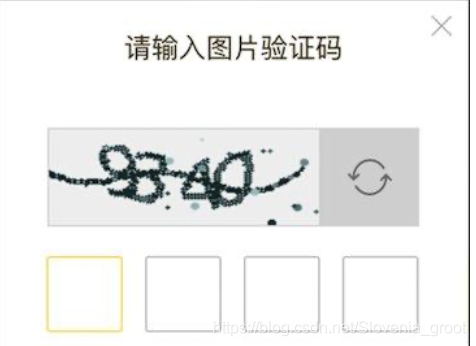我们总是在登录微信,QQ或者其他一些网页的时候,都会出现一个验证码框,他们有的是数字的,有的是文字的,有的是混合的,各种各样的。
很好奇是怎么实现的。带着这样的疑问。



目录

然后在之前创建的随机数方法里,进行循环答应,输出4个随机数

接下来我们需要定义图片的宽度和高度

BufferedImage对象是图片的缓冲流,用于GRB绘制对象,在内存操作过程中,将内存操作的每一个步骤绘制到内存里面存储起来。将缓冲流进行输出。产生一张图片。
//2.定义图片的高度和宽度
int width =120;
int height =25;
//建立bufferedImage对象,制定图片的长度和宽度以及色彩
BufferedImage bi =new BufferedImage(width, height, BufferedImage.TYPE_3BYTE_BGR);
//3.获取Graphics2D 绘制对象,开始绘制验证码
Graphics2D g =bi.createGraphics();
//4.设置文字的子图验证和大小
Font font =new Font("微软雅黑", Font.PLAIN, 20);
//5.设置字体的颜色
Color color =new Color(0,0,0);
//将颜色和字体放入
g.setFont(font);
g.setColor(color);
g.setBackground(new Color(226,226,226));//背景颜色
//开始绘制对象
g.clearRect(0, 0, width, height);
//绘制形状,获取距形对象
FontRenderContext context =g.getFontRenderContext();//文字读取上下文
Rectangle2D bounds =font.getStringBounds(code, context);//将生成的验证码放入
//计算文字的坐标和间距
double x =(width -bounds.getWidth())/2;
double y =(height -bounds.getHeight())/2;
double ascent =bounds.getY();
double baseY =y -ascent;
g.drawString(code, (int)x, (int)y);
//结束配置
g.dispose();
//将图片保存到制定地方,输出
try {
ImageIO.write(bi,"jpg",response.getOutputStream());
//刷新响应流
response.flushBuffer();
} catch (IOException e) {
// TODO Auto-generated catch block
e.printStackTrace();
}
return code;//用于验证码的对比和存储
做完这些后,我们需要定义一个code.jsp页面
<%@ page import="com.kilig.code.CaptcahCode" %>
<%@ page contentType="text/html;charset=UTF-8" language="java" %>
<%
//1:清空浏览器缓存,目的是为了清空浏览器的缓存,因为浏览器
//会对网站的资源文件和图像进行记忆存储,如果被浏览器加载过的图片就记忆起来,记忆以后
//文件就不会和服务器在交互,如果我们验证不清空的话可能会造成一个问题就是:验证刷新以后没有效果。
response.setHeader("pragma","no-cache");
response.setHeader("cache-control","no-cache");
response.setHeader("expires","0");
//2:调用编写的生成验证码的工具
String code = CaptcahCode.drawImage(response);
session.setAttribute("code",code);
//3:如何解决getOutputStream异常问题
out.clear();
out = pageContext.pushBody();
%>
然后在编制输出页面
<%@ page language="java" contentType="text/html; charset=UTF-8"
pageEncoding="UTF-8"%>
<!DOCTYPE html>
<html>
<head>
<meta charset="UTF-8">
<title>Java Verification Code</title>
<meta http-equiv="pragma" content="no-cache">
<meta http-equiv="cache-control" content="no-cache">
<meta http-equiv="expires" content="0">
</head>
<body>
<img src="code.jsp" alt="" id="code">
<a href="javascript:void();" onclick="changeCode()">看不清,点我</a>
<script>
function changeCode(){
document.getElementById("code").src ="code.jsp?d="+new Date().getTime();
}
</script>
</body>
</html>
运行看效果:(每次刷新都不一样)

2.算数表达式验证码


通过观察算数表达式的验证码图片我们得出:
public static String drawImageVerificate(HttpServletResponse response) throws IOException {
//定义验证码的宽度和高度
int width =100, height =30;
//在内存中创建图片
BufferedImage image =new BufferedImage(width,height, BufferedImage.TYPE_INT_RGB);
//创建图片的上下文
Graphics2D g =image.createGraphics();
//创建随机对象,此随机对象主要用于算数表达式的数字
Random random =new Random();
//设置背景
g.setColor(getRandomColor(240,250));
//设置字体
g.setFont(new Font("微软雅黑", Font.PLAIN,22));
//开始绘制
g.fillRect(0,0,width,height);
//干扰线的绘制 ,绘制线条到图片中
g.setColor(getRandomColor(180,230));
for (int i = 0; i <100 ; i++) {
int x =random.nextInt(width);
int y =random.nextInt(height);
int x1 =random.nextInt(60);
int y1 =random.nextInt(60);
g.drawLine(x, y,x1,y1);
}
//开始对算数验证码表达式进行拼接
int num1 =(int)(Math.random()*10+1);
int num2 =(int)(Math.random()*10+1);
int symbel =random.nextInt(3); //定义符号,产生一个[0,2]之间的随机整数
//记录符号
String symbelstr=null;
int result =0;
switch (symbel){
case 0 : symbelstr ="+";result =num1+num2; break;
case 1 : symbelstr ="-";result =num1-num2; break;
case 2 : symbelstr ="*";result =num1*num2; break;
}
//计算表达式
String calc =num1 + " "+ symbelstr +" "+ num2 +"=?";
//设置随机颜色
g.setColor(new Color(20+random.nextInt(110),20+random.nextInt(110),20+random.nextInt(110)));
//绘制表达式
g.drawString(calc, 5, 25);
//结束绘制
g.dispose();
try{
//输出图片到页面
ImageIO.write(image,"JPEG",response.getOutputStream());
return String.valueOf(result);
}catch (Exception ex){
ex.printStackTrace();
return null;
}
//return null;
}
3.使用框架进行实现验证码
kcaptcha实现技术 💁💁💁点击打开kaptcha的官网 网站需要VPN哦,需要VPN的可以私聊我。
Kaptcha是一个基于SimpleCaptcha的验证码开源项目。
1.在官网上下载Kaptcha的相关jar包。并且倒入到lib文件夹中
2.首先配置web.xml

3.然后创建一个页面的jsp index.jsp

启动服务

那么字母的定义,图片的宽度高度,干扰线的设置怎么去配置呢?
下面,从新引入到web.xml
<?xml version="1.0" encoding="UTF-8"?>
<web-app xmlns:xsi="http://www.w3.org/2001/XMLSchema-instance" xmlns="http://xmlns.jcp.org/xml/ns/javaee" xsi:schemaLocation="http://xmlns.jcp.org/xml/ns/javaee http://xmlns.jcp.org/xml/ns/javaee/web-app_4_0.xsd" id="WebApp_ID" version="4.0">
<display-name>Kaptcha</display-name>
<servlet>
<servlet-name>Kaptcha</servlet-name>
<servlet-class>com.google.code.kaptcha.servlet.KaptchaServlet</servlet-class>
<init-param>
<param-name>kaptcha.image.width</param-name>
<param-value>200</param-value>
</init-param>
<init-param>
<param-name>kaptcha.image.height</param-name>
<param-value>50</param-value>
</init-param>
<init-param>
<param-name>kaptcha.textproducer.char.length</param-name>
<param-value>4</param-value>
</init-param>
<init-param>
<param-name>kaptcha.noise.impl</param-name>
<param-value>com.google.code.kaptcha.impl.NoNoise</param-value>
</init-param>
</servlet>
<servlet-mapping>
<servlet-name>Kaptcha</servlet-name>
<url-pattern>/kaptcha.jpg</url-pattern>
</servlet-mapping>
</web-app>
然后运行,进行参数的修改

具体其他参数的配置修改,我从官网上down下来
- Constant 描述 默认值
- kaptcha.border 图片边框,合法值:yes , no yes
- kaptcha.border.color 边框颜色,合法值: r,g,b (and optional alpha) 或者 white,black,blue. black
- kaptcha.border.thickness 边框厚度,合法值:>0 1
- kaptcha.image.width 图片宽 200
- kaptcha.image.height 图片高 50
- kaptcha.producer.impl 图片实现类 com.google.code.kaptcha.impl.DefaultKaptcha
- kaptcha.textproducer.impl 文本实现类 com.google.code.kaptcha.text.impl.DefaultTextCreator
- kaptcha.textproducer.char.string 文本集合,验证码值从此集合中获取 abcde2345678gfynmnpwx
- kaptcha.textproducer.char.length 验证码长度 5
- kaptcha.textproducer.font.names 字体 Arial, Courier
- kaptcha.textproducer.font.size 字体大小 40px
- kaptcha.textproducer.font.color 字体颜色,合法值: r,g,b 或者 white,black,blue. black
- kaptcha.textproducer.char.space 文字间隔 2
- kaptcha.noise.impl 干扰实现类 com.google.code.kaptcha.impl.DefaultNoise
- kaptcha.noise.color 干扰颜色,合法值: r,g,b 或者 white,black,blue. black
- kaptcha.obscurificator.impl 图片样式:
- 水纹com.google.code.kaptcha.impl.WaterRipple
- 鱼眼com.google.code.kaptcha.impl.FishEyeGimpy
- 阴影com.google.code.kaptcha.impl.ShadowGimpy
- com.google.code.kaptcha.impl.WaterRipple
- kaptcha.background.impl 背景实现类 com.google.code.kaptcha.impl.DefaultBackground
- kaptcha.background.clear.from 背景颜色渐变,开始颜色 light grey
- kaptcha.background.clear.to 背景颜色渐变,结束颜色 white
- kaptcha.word.impl 文字渲染器
- com.google.code.kaptcha.text.impl.DefaultWordRenderer
- kaptcha.session.key session key KAPTCHA_SESSION_KEY
- kaptcha.session.date session date KAPTCHA_SESSION_DATE
举个例子,比方说加入对文字内容的配置 ,要求只可以是123456789数字

让我们运行看一看,就会产生一个只有4位数字,并且宽度200,高度50的没有干扰线的验证码图片

不同方式的组合配置,会有不同的效果:

4.案例学习:
我们引入第三方的框架:jquery
增加一个时间搓,点击功能,当店家页面,实现刷新

在编写一个javascript的方法,看是否可以获取我们的用户输入的验证码


此时我们的客户端以及做好了,我们去完成我们的服务端的设计
在上面的介绍里,我们认识到,获取验证码框的函数是 kaptcha.session.key session key KAPTCHA_SESSION_KEY

如果用户输入的验证码和产生在服务器端的验证码一致,那么用户输入成功
equalsIgnoreCase(); 方法,不用区分大小写



LoginServlet
package com.kilig.code;
import java.io.IOException;
import java.io.PrintWriter;
import javax.servlet.ServletException;
import javax.servlet.annotation.WebServlet;
import javax.servlet.http.HttpServlet;
import javax.servlet.http.HttpServletRequest;
import javax.servlet.http.HttpServletResponse;
import javax.swing.text.StyleConstants.CharacterConstants;
import com.google.code.kaptcha.Constants;
@WebServlet("/LoginServlet")
public class LoginServlet extends HttpServlet {
protected void doGet(HttpServletRequest request, HttpServletResponse response)
throws ServletException, IOException {
//设置编码
request.setCharacterEncoding("UTF-8");
response.setCharacterEncoding("UTF-8");
//需要获取浏览器的输出流对象
PrintWriter out =response.getWriter();
//获取用户传递过来的验证码
String code =request.getParameter("code");
//获取验证码框架产生的验证码
String sessionCode =(String)request.getSession().getAttribute(Constants.KAPTCHA_SESSION_KEY);
System.out.println(code+"===="+sessionCode);
if(code != null && sessionCode != null) {
//如果用户输入的验证码和产生在服务器端的验证码一致,那么用户输入成功
if(code.equalsIgnoreCase(sessionCode)) {
System.out.println("Success");
}else {
System.out.println("Fail");
}
}else {
System.out.println("Fail");
}
//刷新和关闭
out.flush();
out.close();
}
protected void doPost(HttpServletRequest request, HttpServletResponse response)
throws ServletException, IOException {
doGet(request, response);
}
}
test.jsp
<%@ page language="java" contentType="text/html; charset=UTF-8"
pageEncoding="UTF-8"%>
<!DOCTYPE html>
<html>
<head>
<meta charset="UTF-8">
<title>Insert title here</title>
<style>#code{height:25px;}</style>
</head>
<body>
<form action="submit.action">
<p>验证码:<input type="text",name="kaptcha", id="code" maxlength="4" placeholder="请输入验证码">
<img src="kaptcha.jpg" id ="changeCode"/></p>
<p><input type="button" value="登录" id="login"></p>
<div id="result"></div>
</form>
<script src="js/jquery-1.12.4.min.js"></script>
<script>
$(function(){
$("#changeCode").on("click",function(){
$(this).attr("src","kaptcha.jpg?d="+new Date().getTime());
})
//给登录按钮绑定登录事件
$("#login").on("click",function(){
//获取用户输入的验证码
var code =$("#code").val();
var params ={"code":code};
$.post("login",params,function(data){
if(data =="Success"){
$("#result").html("验证码输入正确!!");
}else{
$("#result").html("验证码输入有误,请重新输入。。。");
$("#code").val("").focus();
}
});
});
});
</script>
</body>
</html>
web.xml
<?xml version="1.0" encoding="UTF-8"?>
<web-app xmlns:xsi="http://www.w3.org/2001/XMLSchema-instance" xmlns="http://xmlns.jcp.org/xml/ns/javaee" xsi:schemaLocation="http://xmlns.jcp.org/xml/ns/javaee http://xmlns.jcp.org/xml/ns/javaee/web-app_4_0.xsd" id="WebApp_ID" version="4.0">
<display-name>Web</display-name>
<servlet>
<servlet-name>Kaptcha</servlet-name>
<servlet-class>com.google.code.kaptcha.servlet.KaptchaServlet</servlet-class>
<init-param>
<param-name>kaptcha.image.width</param-name>
<param-value>200</param-value>
</init-param>
<init-param>
<param-name>kaptcha.image.height</param-name>
<param-value>50</param-value>
</init-param>
<init-param>
<param-name>kaptcha.textproducer.char.length</param-name>
<param-value>4</param-value>
</init-param>
<init-param>
<param-name>kaptcha.noise.impl</param-name>
<param-value>com.google.code.kaptcha.impl.NoNoise</param-value>
</init-param>
<!-- "kcode"生成好的验证码 -->
<!--
<init-param>
<param-name>kaptcha.session.key </param-name>
<param-value>kcode</param-value>
</init-param>
-->
</servlet>
<servlet-mapping>
<servlet-name>Kaptcha</servlet-name>
<url-pattern>/kaptcha.jpg</url-pattern>
</servlet-mapping>
<!-- 注册LoginServlet -->
<servlet>
<servlet-name>LoginServlet</servlet-name>
<servlet-class>com.kilig.code.LoginServlet</servlet-class>
</servlet>
<servlet-mapping>
<servlet-name>LoginServlet</servlet-name>
<url-pattern>/login</url-pattern>
</servlet-mapping>
</web-app>
 1万+
1万+
 220
220
 4108
4108
 小白启示录
小白启示录
 Java学习
15篇
Java学习
15篇
 Java Web
15篇
Java Web
15篇
 课程学习
2篇
课程学习
2篇
 Web全栈常见错误
2篇
Web全栈常见错误
2篇
 Anaconda Error
1篇
Anaconda Error
1篇
 Web各种工具搭建教程
5篇
Web各种工具搭建教程
5篇
 Packer Tracter
2篇
Packer Tracter
2篇




 小白启示录
小白启示录
 Java学习
15篇
Java学习
15篇
 Java Web
15篇
Java Web
15篇
 课程学习
2篇
课程学习
2篇
 Web全栈常见错误
2篇
Web全栈常见错误
2篇
 Anaconda Error
1篇
Anaconda Error
1篇
 Web各种工具搭建教程
5篇
Web各种工具搭建教程
5篇
 Packer Tracter
2篇
Packer Tracter
2篇


 点击重新获取
点击重新获取


 扫码支付
扫码支付
 余额充值
余额充值